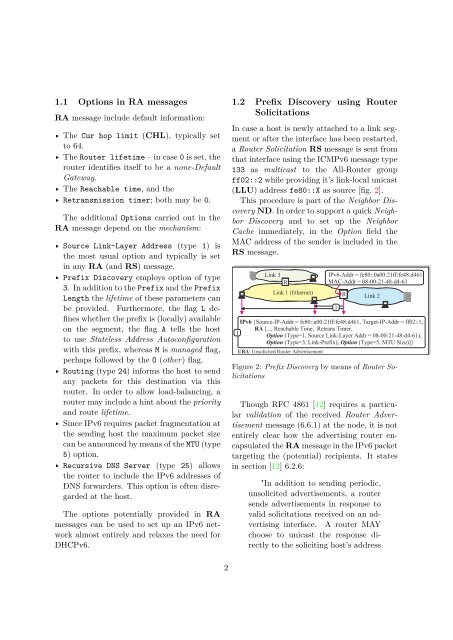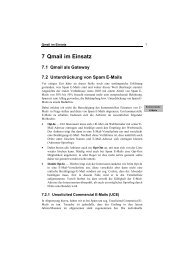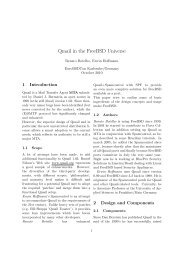What is wrong with the IPv6 RA protocol ? - FEHCom
What is wrong with the IPv6 RA protocol ? - FEHCom
What is wrong with the IPv6 RA protocol ? - FEHCom
Create successful ePaper yourself
Turn your PDF publications into a flip-book with our unique Google optimized e-Paper software.
1.1 Options in <strong>RA</strong> messages<br />
<strong>RA</strong> message include default information:<br />
The Cur hop limit (CHL), typically set<br />
to 64.<br />
The Router lifetime – in case 0 <strong>is</strong> set, <strong>the</strong><br />
router identifies itself to be a none-Default<br />
Gateway.<br />
The Reachable time, and <strong>the</strong><br />
Retransm<strong>is</strong>sion timer; both may be 0.<br />
The additional Options carried out in <strong>the</strong><br />
<strong>RA</strong> message depend on <strong>the</strong> mechan<strong>is</strong>m:<br />
Source Link-Layer Address (type 1) <strong>is</strong><br />
<strong>the</strong> most usual option and typically <strong>is</strong> set<br />
in any <strong>RA</strong> (and RS) message.<br />
Prefix D<strong>is</strong>covery employs option of type<br />
3. In addition to <strong>the</strong> Prefix and <strong>the</strong> Prefix<br />
Length <strong>the</strong> lifetime of <strong>the</strong>se parameters can<br />
be provided. Fur<strong>the</strong>rmore, <strong>the</strong> flag L defines<br />
whe<strong>the</strong>r <strong>the</strong> prefix <strong>is</strong> (locally) available<br />
on <strong>the</strong> segment, <strong>the</strong> flag A tells <strong>the</strong> host<br />
to use Stateless Address Autoconfiguration<br />
<strong>with</strong> th<strong>is</strong> prefix, whereas M <strong>is</strong> managed flag,<br />
perhaps followed by <strong>the</strong> O (o<strong>the</strong>r) flag.<br />
Routing (type 24) informs <strong>the</strong> host to send<br />
any packets for th<strong>is</strong> destination via th<strong>is</strong><br />
router. In order to allow load-balancing, a<br />
router may include a hint about <strong>the</strong> priority<br />
and route lifetime.<br />
Since <strong>IPv6</strong> requires packet fragmentation at<br />
<strong>the</strong> sending host <strong>the</strong> maximum packet size<br />
can be announced by means of <strong>the</strong> MTU (type<br />
5) option.<br />
Recursive DNS Server (type 25) allows<br />
<strong>the</strong> router to include <strong>the</strong> <strong>IPv6</strong> addresses of<br />
DNS forwarders. Th<strong>is</strong> option <strong>is</strong> often d<strong>is</strong>regarded<br />
at <strong>the</strong> host.<br />
The options potentially provided in <strong>RA</strong><br />
messages can be used to set up an <strong>IPv6</strong> network<br />
almost entirely and relaxes <strong>the</strong> need for<br />
DHCPv6.<br />
2<br />
1.2 Prefix D<strong>is</strong>covery using Router<br />
Solicitations<br />
In case a host <strong>is</strong> newly attached to a link segment<br />
or after <strong>the</strong> interface has been restarted,<br />
a Router Solicitation RS message <strong>is</strong> sent from<br />
that interface using <strong>the</strong> ICMPv6 message type<br />
133 as multicast to <strong>the</strong> All-Router group<br />
ff02::2 while providing it’s link-local unicast<br />
(LLU) address fe80::X as source [fig. 2].<br />
Th<strong>is</strong> procedure <strong>is</strong> part of <strong>the</strong> Neighbor D<strong>is</strong>covery<br />
ND. In order to support a quick Neighbor<br />
D<strong>is</strong>covery and to set up <strong>the</strong> Neighbor<br />
Cache immediately, in <strong>the</strong> Option field <strong>the</strong><br />
MAC address of <strong>the</strong> sender <strong>is</strong> included in <strong>the</strong><br />
RS message.<br />
E !<br />
4<br />
E - J D A H A J<br />
1 2 L $ 5 K H ? A 1 2 ) @ @ H B A & = B B B A " & @ " $ 6 = H C A J 1 2 ) @ @ H B B <br />
4 ) 4 A = ? D = > A 6 E A 4 A J H = I 6 E A H <br />
F J E 6 O F A 5 K H ? A E = O A H ) @ @ H & " & @ " $ <br />
F J E 6 O F A ! E 2 H A B E N F J E 6 O F A # 6 7 5 E A <br />
7 4 ) 7 I E ? E J A @ 4 K J A H ) @ L A H J E I A A J<br />
1 2 L $ ) @ @ H B A & = B B B A " & @ " $<br />
) + ) @ @ H & " & @ " $<br />
Figure 2: Prefix D<strong>is</strong>covery by means of Router Solicitations<br />
Though RFC 4861 [12] requires a particular<br />
validation of <strong>the</strong> received Router Advert<strong>is</strong>ement<br />
message (6.6.1) at <strong>the</strong> node, it <strong>is</strong> not<br />
entirely clear how <strong>the</strong> advert<strong>is</strong>ing router encapsulated<br />
<strong>the</strong> <strong>RA</strong> message in <strong>the</strong> <strong>IPv6</strong> packet<br />
targeting <strong>the</strong> (potential) recipients. It states<br />
in section [12] 6.2.6:<br />
44<br />
E <br />
"In addition to sending periodic,<br />
unsolicited advert<strong>is</strong>ements, a router<br />
sends advert<strong>is</strong>ements in response to<br />
valid solicitations received on an advert<strong>is</strong>ing<br />
interface. A router MAY<br />
choose to unicast <strong>the</strong> response directly<br />
to <strong>the</strong> soliciting host’s address




